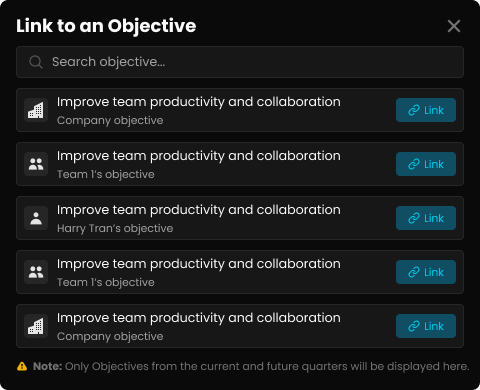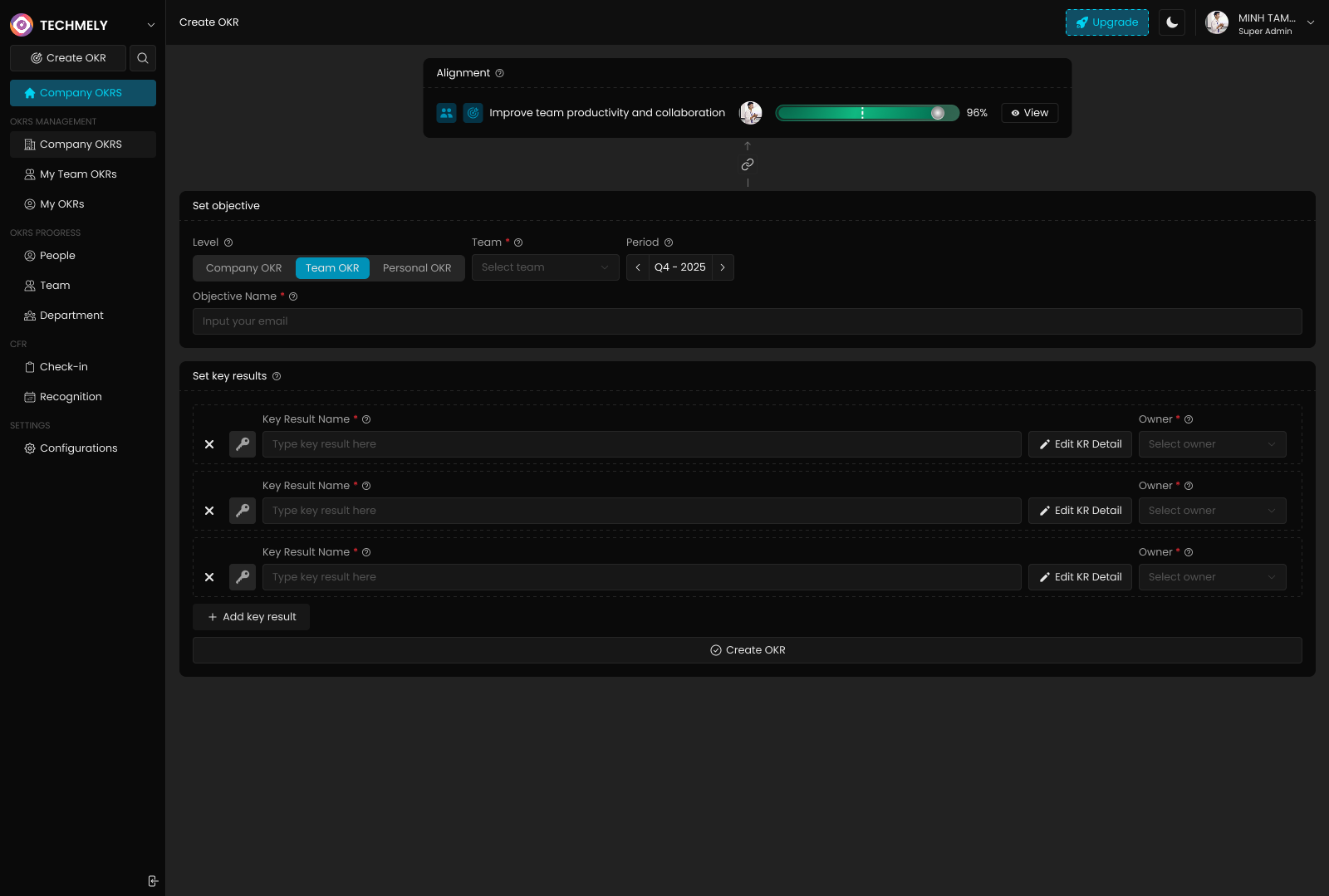Link Objectives for Strategic Alignment
Complete guide to linking objectives in AntOKR to create strategic alignment and cascade goals across your organization
Link Objectives for Strategic Alignment
Overview
Objective linking is a powerful feature in AntOKR that allows you to connect objectives across different levels of your organization. This creates clear line of sight from individual work to company strategy, ensuring everyone understands how their efforts contribute to organizational success.
What is Objective Linking?
Objective linking creates a parent-child relationship between objectives where:
- Child objectives become key results of the parent objective
- Progress of child objectives impacts parent objective progress
- Alignment becomes visible and trackable across levels
- Strategic cascade flows from company to team to individual levels
Benefits of Linking Objectives
Strategic Alignment
- Clear connection between different organizational levels
- Visible impact of individual work on company goals
- Better resource allocation and prioritization
- Enhanced strategic communication
Progress Tracking
- Automatic progress updates from child to parent objectives
- Real-time visibility into organizational performance
- Early identification of strategic risks
- Data-driven decision making
Team Coordination
- Better understanding of interdependencies
- Improved cross-team collaboration
- Reduced duplicate efforts
- Enhanced organizational coherence
How Objective Linking Works
When you link objectives in AntOKR:
- The child objective becomes a "Key Result" of the parent objective
- Progress percentage of the child objective automatically updates the parent
- The child objective retains its own key results and identity
- Weight is assigned to determine the child's impact on parent progress (default: 1x)

Step-by-Step Linking Process
Step 1: Identify Linking Opportunities
Before linking objectives, identify where connections make strategic sense:
From Company to Team Level:
- Team objectives that directly support company goals
- Initiatives that require team-level execution
- Strategic priorities that need departmental focus
From Team to Personal Level:
- Individual objectives that support team goals
- Personal development that enhances team capabilities
- Projects requiring individual ownership
Step 2: Access the Linking Interface
When creating or editing an objective, look for the linking option:
- During OKR Creation: Look for "Click to Link" option
- After Creation: Edit existing objectives to add links
- Search Interface: Use the search function to find parent objectives
Step 3: Select Parent Objective
The linking interface shows available parent objectives:

Available Options Include:
- Company objectives (shown with building icon)
- Team objectives (shown with team icon)
- Personal objectives (shown with person icon)
- Different time periods (current and future quarters)
Selection Criteria:
- Objectives from current and future quarters only
- Same or longer time periods (cannot link annual to quarterly)
- Appropriate level relationships (no company to team linking)
Step 4: Confirm the Link
After selecting a parent objective:
- Review the connection - Ensure logical alignment
- Check impact - Understand how progress will flow
- Confirm the link - Finalize the relationship
- Verify display - See the linked objective in your alignment view

Linking Rules and Constraints
Time Period Rules
- Current to Future: Can link objectives from current quarter to future quarters
- Same Period: Can link objectives within the same time period
- No Backward Linking: Cannot link to past/completed quarters
- Period Length: Cannot link longer periods to shorter ones (annual → quarterly not allowed)
Level Restrictions
- Company Objectives: Cannot be linked to team objectives (must remain top-level)
- Team to Personal: Team objectives can be linked to personal objectives
- Personal to Team: Personal objectives can be linked to team objectives
- Cross-Department: Can link across teams and departments
Permission Requirements
- Owner Permission: Must have permission to modify both objectives
- Team Access: For team objectives, must be member of relevant teams
- Administrative Rights: Some cross-level linking may require admin privileges
Best Practices for Objective Linking
1. Start with Clear Strategy
Before Linking:
- Define clear company strategy and priorities
- Ensure leadership alignment on top-level objectives
- Communicate the "why" behind strategic goals
- Create shared understanding of success metrics
2. Create Logical Hierarchies
Recommended Flow:
Company Objectives
↓ (supported by)
Team/Department Objectives
↓ (supported by)
Individual/Personal Objectives
Example Hierarchy:
- Company: "Become market leader in customer satisfaction"
- Customer Success Team: "Achieve 95% customer satisfaction scores"
- Individual CSM: "Maintain 4.8+ rating with assigned accounts"
- Customer Success Team: "Achieve 95% customer satisfaction scores"
3. Maintain Appropriate Granularity
Company Level (3-5 objectives):
- Strategic, high-level outcomes
- Cross-organizational impact
- Quarterly or annual timeframes
Team Level (3-4 objectives):
- Department-specific goals
- Supporting company objectives
- Quarterly focus areas
Individual Level (2-4 objectives):
- Personal development and performance
- Contributing to team success
- Skill building and capability enhancement
4. Regular Alignment Reviews
Weekly Team Reviews:
- Check progress on linked objectives
- Identify blockers affecting parent goals
- Coordinate cross-team dependencies
- Celebrate aligned achievements
Monthly Leadership Reviews:
- Assess overall alignment health
- Review linked objective progress
- Address strategic misalignments
- Plan adjustments as needed
Common Linking Scenarios
Scenario 1: Product Launch Campaign
Company Objective: "Successfully launch new product line"
- Marketing Team: "Generate awareness and leads for new product"
- Marketing Manager: "Develop comprehensive product launch campaign"
- Sales Team: "Achieve initial sales targets for new product"
- Sales Rep: "Close 10 deals using new product in first month"
Scenario 2: Customer Experience Improvement
Company Objective: "Improve overall customer experience"
- Customer Success Team: "Reduce customer churn by 30%"
- CSM: "Maintain proactive communication with at-risk accounts"
- Product Team: "Enhance product usability based on feedback"
- UX Designer: "Redesign 5 key user workflows"
Scenario 3: Operational Excellence
Company Objective: "Achieve operational excellence across all functions"
- Engineering Team: "Improve system reliability and performance"
- DevOps Engineer: "Achieve 99.9% uptime for all services"
- Finance Team: "Optimize cost management and financial reporting"
- Financial Analyst: "Implement automated reporting for key metrics"
Managing Linked Objectives
Progress Tracking
Automatic Updates:
- Child objective progress automatically updates parent
- Weight determines contribution percentage
- Real-time visibility across all levels
- Historical tracking of progress changes
Manual Adjustments:
- Ability to adjust weights if priorities change
- Option to unlink objectives if alignment shifts
- Regular review of linking relevance
Communication and Transparency
Alignment Visibility:
- All stakeholders can see objective connections
- Clear understanding of impact and dependencies
- Enhanced accountability across levels
- Better strategic communication
Performance Management
Integrated Reviews:
- Linked objectives in performance discussions
- Clear contribution to organizational goals
- Recognition for aligned achievements
- Development planning based on strategic needs
Warning: Unlinked Objectives

AntOKR may show warnings for objectives that aren't linked to parent objectives. This reminder helps ensure:
- Strategic alignment is maintained
- Orphaned objectives are identified
- Strategic gaps are addressed
- Complete cascade is achieved
When to Link:
- Objective directly supports higher-level goal
- Clear contribution to organizational strategy
- Meaningful impact on parent objective progress
When NOT to Link:
- Independent innovation projects
- Exploratory or experimental objectives
- Personal development not directly tied to current strategy
- Operational maintenance activities
Troubleshooting Linking Issues
Cannot Find Parent Objective
Possible Causes:
- Time period restrictions (past quarters not available)
- Permission limitations (no access to target objective)
- Level restrictions (trying to link company to team)
Solutions:
- Check time periods and adjust as needed
- Verify permissions with team leads or administrators
- Consider alternative parent objectives at appropriate level
Progress Not Updating
Possible Causes:
- Caching delays in system
- Incorrect weight assignments
- Manual overrides blocking automatic updates
Solutions:
- Wait for system refresh (typically 5-10 minutes)
- Check and adjust weight settings
- Review parent objective configuration
Strategic Misalignment
Possible Causes:
- Changing business priorities
- Incorrect initial linking decisions
- Evolving organizational structure
Solutions:
- Regular alignment reviews with leadership
- Quarterly re-evaluation of linking relationships
- Adjustment of links based on strategic changes
Next Steps
After setting up objective linking:
- Communicate: Share the alignment structure with all stakeholders
- Monitor: Track progress and impact across linked objectives
- Review: Regularly assess the effectiveness of linkages
- Adjust: Make changes as strategy or priorities evolve
- Celebrate: Recognize achievements that demonstrate strong alignment
Advanced Linking Strategies
Multi-Level Cascades
Create comprehensive alignment from CEO to individual contributor:
- CEO sets company objectives
- VPs create department objectives linked to company goals
- Directors set team objectives linked to department goals
- Managers create individual objectives linked to team goals
Cross-Functional Alignment
Link objectives across different teams working on shared outcomes:
- Product and Engineering teams linked on feature delivery
- Sales and Marketing teams aligned on revenue generation
- Customer Success and Product teams connected on user experience
Innovation and Core Business Balance
Maintain balance between:
- Core business objectives (linked to company goals)
- Innovation objectives (may be unlinked to allow exploration)
- Development objectives (personal growth supporting future capabilities)
Objective linking is essential for creating organizational alignment and ensuring that everyone's work contributes meaningfully to company success. When implemented thoughtfully, it transforms individual efforts into coordinated organizational achievement.
Suggested Related Articles
Manage OKR Actions
Complete guide to managing OKR actions including editing, updating, linking, and deleting objectives and key results
Company Configuration
Complete guide to configuring and managing your company settings, branding, and organizational preferences in AntOKR
Create Team-Level OKR
Step-by-step guide to creating effective team-level Objectives and Key Results in AntOKR
Create Company
Learn how to set up your company profile in AntOKR with step-by-step instructions
Team Management
Complete guide to creating, managing, and organizing teams within your AntOKR organization for effective collaboration and OKR execution
OKR Management Overview
Complete guide to navigating and understanding OKR management interface across Company, Team, and Personal levels